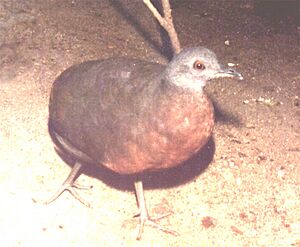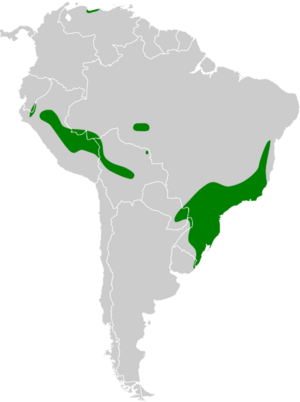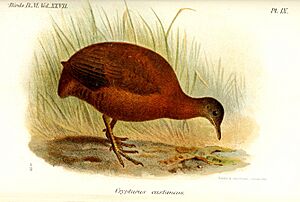Brown tinamou facts for kids
The brown tinamou (Crypturellus obsoletus) is a shy, brownish bird that lives on the ground. You can find it in warm, wet forests across tropical and subtropical South America. It prefers both lowland areas and forests on mountains.
Quick facts for kids Brown tinamou |
|
|---|---|
 |
|
| Conservation status | |
| Scientific classification | |
| Genus: |
Crypturellus
|
| Species: |
obsoletus
|
| Subspecies | |
|
C. o. obsoletus |
|
 |
|
Contents
What is a Brown Tinamou?
Brown tinamous belong to a bird family called Tinamidae. Even though they can fly, they are related to a group of large, flightless birds called ratites. This group includes well-known birds like ostriches, emus, and kiwis.
Scientists believe that tinamous are very similar to the ancient birds that all ratites evolved from. This makes them a special link to the past!
Different Types of Brown Tinamous
The brown tinamou lives in many different places, and because of this, there are several slightly different types, called subspecies. These subspecies might even be separate species, but scientists are still studying them. Here are some of them:
- C. o. obsoletus: This is the main type. It lives in the Atlantic forest in southeastern Brazil, eastern Paraguay, and Misiones, Argentina.
- C. o. griseiventris: Found around the Rio Tapajós in Brazil.
- C. o. hypochraceus: Lives in the upper Rio Madeira valley in central Rondônia, Brazil.
- C. o. punensis: Found in the Yungas region of central Bolivia and southeastern Peru.
- C. o. traylori (also called Traylor's tinamou): Lives in the Marcapata Valley in southeastern Peru. Some scientists think this might be its own species.
- C. o. ochraceiventris: Found along the eastern Andean mountains in central Peru.
- C. o. castaneus: Lives east of the Andes in northern Peru, Ecuador, and Colombia. This one is also sometimes considered a separate species.
- C. o. knoxi: Found in northwestern Venezuela.
- C. o. cerviniventris: Lives in northern Venezuela.
Most of these subspecies live in high mountain areas. However, some, like hypochraceus and griseiventris, live in lower lands. Brown tinamous are not very common in most places, but you might see more of them in southeastern Brazil.
What's in a Name?
The scientific name for the brown tinamou is Crypturellus obsoletus. The first part, Crypturellus, comes from three Latin or Greek words:
- kruptos means covered or hidden
- oura means tail
- ellus means small
So, Crypturellus means "small hidden tail," which describes how their tails are often hard to see.
Appearance of the Brown Tinamou
The brown tinamou is about 25 to 30 cm (9.8–11.8 in) long. It weighs around 350 to 550 g (12–19 oz), which is about the same as a can of soup.
Their feathers can be different shades of brown. The top part of their body can range from a dark, smoky brown to a bright reddish-brown. Their undersides are usually lighter, from reddish-brown to a light yellowish-brown. One subspecies, griseiventris, is special because it has pale gray-yellow undersides.
You can tell a brown tinamou apart from a similar bird called the little tinamou because the brown tinamou has a grayish throat, not a whitish one. Female brown tinamous are usually a bit bigger and have more reddish feathers than the males.
How Brown Tinamous Behave
Like other tinamous, the brown tinamou is a very shy bird that lives on the ground. You will usually see them alone or in pairs. They like to eat fruits, insects, and seeds they find on the forest floor.
When it's time to lay eggs, the female tinamou lays 4 to 5 eggs directly on the ground. She usually chooses a small dip in the soil at the bottom of a tree. The eggs can be a beautiful deep pink or a dark, shiny brown.
Their song is a loud, high-pitched whistle. The exact sound of their whistle can change depending on where they live.
Where They Live and Their Home
Brown tinamous live in many countries in South America. You can find them in northern Venezuela, Colombia, Ecuador, Peru, northern and southern Brazil, northeastern Argentina, eastern Bolivia, and eastern Paraguay. There are also some records of them possibly living in Uruguay.
They prefer to live in warm, wet lowland forests and montane forests (forests on mountains). They are often found at elevations between 1,300 to 2,900 m (4,300–9,500 ft) high.
Protecting the Brown Tinamou
The IUCN (International Union for Conservation of Nature) has classified the brown tinamou as a species of Least Concern. This means that, for now, they are not considered to be in danger of disappearing. They live across a very large area, covering about 1,700,000 km2 (660,000 sq mi).



